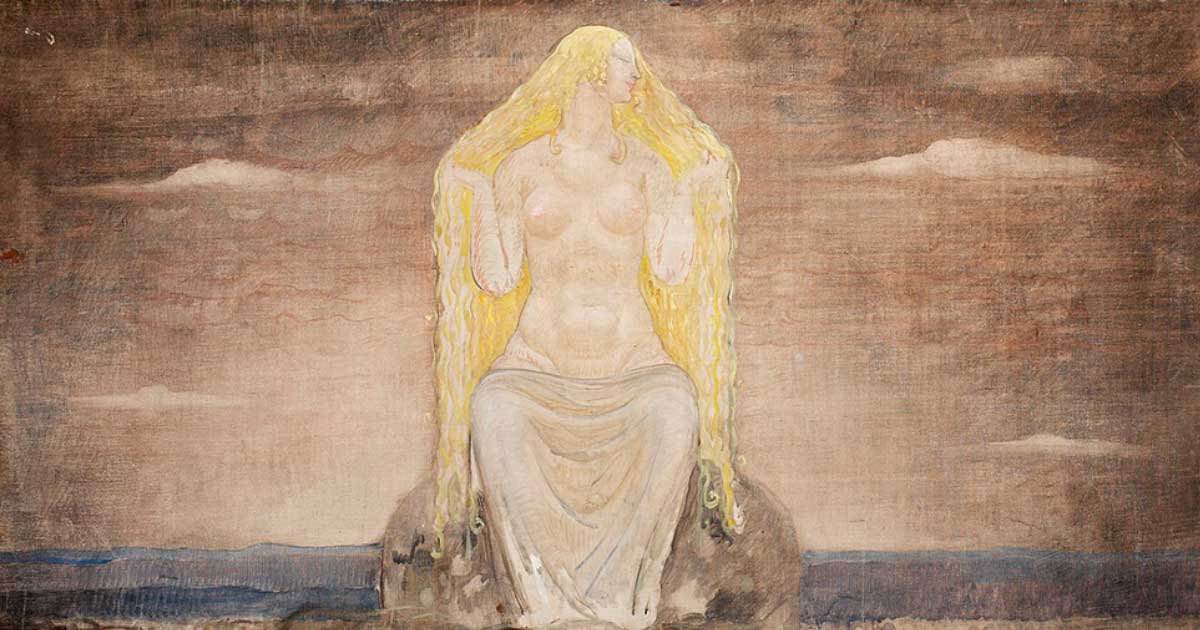The Story, Symbols and Powers of Freya, the Norse Goddess of Love
Freya is old Norse for “lady” and was the name given to the Norse goddess of love. Whilst she certainly sought out passion and pleasure, she was a complex character. In fact, to the Vikings she was a powerful force, a goddess on par with Odin and Thor within the legends of Norse mythology.
The Powers of Freya
While Freya, a.k.a. Freyja, Freja, Fröja or Frøya, is most known as the goddess of love, she also oversaw fertility, battle, and death. The mythology related to her emphasizes her role in all things related to sexuality. However, she seems to have been completely excluded from childbirth, an aspect of fertility which was within the purview of other goddesses of the same nature.
- Odin’s Women – Goddesses Ignored, Forgotten and Denied Valhalla
- Skaði, The Norse ‘Giantess’ with a Godly Vendetta
Because of her links to the very beginnings of life, she probably played an important role in early Scandinavian religion. One of her most influential roles, was the ability to choose half of all the heroes who died in battle to take to her great hall in Folkvangar (which translates to “field of the people”). The other half would have been chosen by Odin who would then take them to Valhalla. In terms of which god selected who, it seemed to depend on the social status of the dead hero.
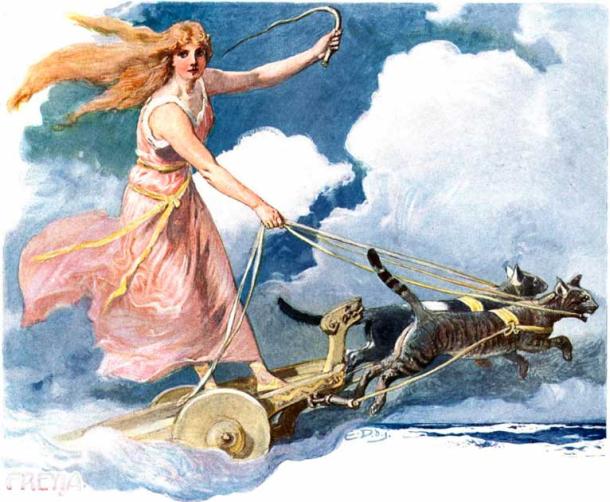
Freya drives her cat chariot by Emil Doepler. (Public domain)
Freya’s Attributes within Norse Culture
There were many attributes and possessions associated with Freya. She deemed pigs to be sacred to her, rode a boar and drove a chariot driven by cats. She was also said to have owned either a coat, cloak or dress which was made of falcon feathers. Freya was also associated with witchcraft and some myths record her teaching the practice to the Norse Aesir gods.
Evidence for the boar comes from the Hyndluljóð, an ancient Norse poem, which names the animal Hildisvíni. Her brother Freyre was also said to own a boar named Gullinborsti. H. R. Ellis Davidson also links Freya to horses and argues that they were particularly associated with the goddess and were kept in her holy places.
She also owned a necklace named Brísingamen, connected to a story involving the mischievous god Loki. The necklace seems to have been attributed to Freya in the 13th and 14th centuries by late Old Norse sources. The name is said to translate to “necklace of the Brisings,” however its meaning is unclear. The Norwegian word brisa means shrine and some believe the necklace’s name relates to that. Others think it may be related to the words Brosinga mene from the Beowulf poem.
Freya was also known by four other nicknames - Mardöll, Hörn, Gefn, and Sýr. The name Sýr is sometimes translated to “sow,” but could also mean “to shield” or “protect,” while the name Hörn most likely comes from the Old Norse Horr which translates to “flax” or “linen.”
The link here may be the fact that in Scandinavian culture, linen was an important product which was believed to prevent evil and provide fertility. The manufacture of flax was a woman’s role and was largely associated with weddings because linen was used to make bridal dresses. Meanwhile, Gefn translates as “giver” in Old Norse. The links to Freya’s responsibilities are clear here; she brings life and love.
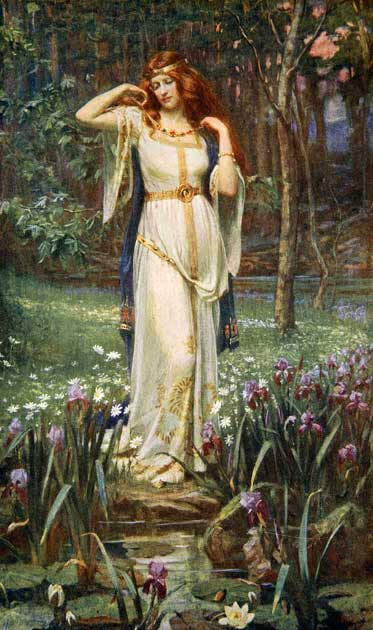
Freyja and the Necklace by James Doyle Penrose. (Public domain)
Freya’s Family Tree and the Vanir Gods
Freya belonged to a family of Vanir Gods who oversaw most things fertility related. It is said that she had a twin brother (Freyre) who oversaw the harvest. Her father was Njörd (Old Norse: Njörðr) the god of the sea who oversaw the sea, wind and wealth. Njörd was said to reside in Nóatún, which was located next to the sea. Freyre, her twin brother, was also born in the Vanir tribe, however, he ends up living in the realm of Alfheim which was presented to him as a gift by the Aesir.
There is some contention over who her mother was. Some records state she could have been an unknown sister of Njörd. Others say her mother was Nerthus, the Norse version of Mother Earth personified. Some say her mother was the daughter and wife of Njörd, Skadi the giant.
Freya was born into the Vanir branch of the Gods who lived in the realm known as Vanaheim. However, there is a myth which details her switch to the other tribe of gods known as the Aesir, to whom Thor and Odin belonged. After this switch, she lived in Asgard, the Norse equivalent to the Greek Mount Olympus, alongside her husband Ódr (Old Norse: Óðr).
As with her mother, there is disagreement within the sources about who her husband was and his potential links to the Odin. Some have argued that Freya was identical to Odin’s wife Figg, and the two have often been interpreted as being the same person. Some sources discard Ódr completely and instead record Freyre (her brother) as Freya’s husband. However, the Icelandic Snorri Sturluson (1179-1241), who compiled the most complete record of Norse mythology, records Ódr as her husband.
Freya and Ódr are said to have had two daughters by the names of Hnoss and Gersemi, both of whose names mean treasure. They are only ever referred to as Freya’s daughters and there is nothing else recorded about their lives. Despite this, the fact that their names are linked to treasure can be seen as a link to Freya’s reputation as a prize to be won or demanded in the many myths involving her. It also links to the myth where Freya was said to weep tears of gold.
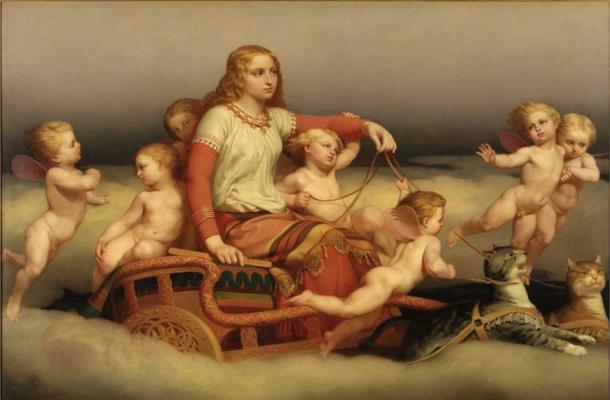
Freja Seeking her Husband by Nils Blommér. (Public domain)
Freya and the Art of Seidr Magic
There are many myths that involve the mention of Freya in Old Norse sources. There are some stories that tell of Freya travelling the world searching for her lost husband and crying tears made of gold. This myth seems to originate as early as the 10th century.
Another myth tells of her switch from the Aesir tribe to the Vanir tribe of gods. This happened because of the Aesir-Vanir War which broke out because of hostility and fundamental dissimilarities between the Aesir and Vanir in terms of their culture. When they eventually came to an agreement, Freya, her brother Freyre, and her father were sent over to the Aesir as a sort of collateral.
The three were eventually accepted by the Aesir as one of their own, and Freya soon taught the Aesir gods the ways of seidr, the name for a kind of ancient Norse magic. Freya was also one of the völva, a seeress who was part of a group of female seers or shamans. They practiced seidr magic which was the most organized form of magic in the Norse world. Norse myths record that Freya was the first to present this art to the gods and then to humankind.
The art of seidr involved using magic in order to understand the course of fate and then working in conjunction with it to bring about change. Those who practiced seidr attempted to weave new events into life. This power could be used in any way the seer imagined. This could be in order to bring about negative consequences like illness or bad luck, or even for inflicting pain and injury. It could also be used for positive reasons such as to cure illness, bring good luck, win a battle or find hidden objects.
During Norse times, these people would travel across the land taking on commissioned acts of magic in exchange for anything from food to lodging. Like many individuals who practiced magic throughout history, the social status of a seeress or sorceress was ambiguous. By some Freya was feared for her abilities, by others she was longed after.
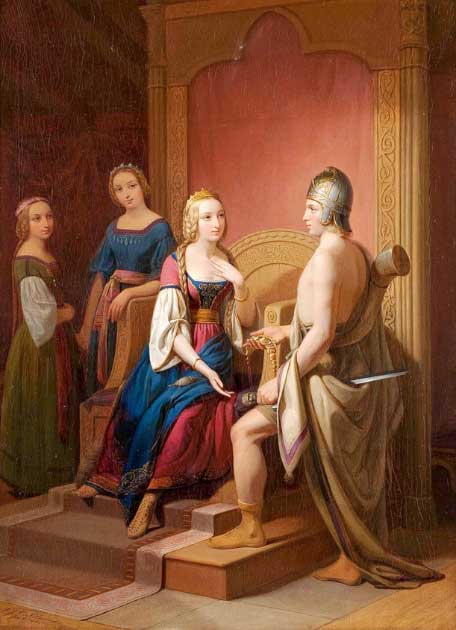
Heimdall returns the necklace Bryfing to Freya. (Public domain)
The evidence for Freya bringing this art to the gods can be found in the Ynglinga Saga, a work written by the Icelandic poet and historian Snorri Sturluson in 1225, as well as in evidence found in the Eddas, two medieval Icelandic literary works. Furthermore, the theme of fate is one that features heavily in much of Norse mythology.
Further Myths of Freya
In one of the Eddic poems, Freya is accused by Loki of sleeping with all of the gods and elves, including her family! Another myth also involves Loki as well as Freya’s necklace Brisingamen. A lot of the literary sources do not mention the story in detail and only simply refer to Loki as the thief of Brisingamen. Those that mention Loki’s involvement only remain in a fragmentary state and so the comprehensive story has been lost to time.
In other sources, Heimdall and Loki fight for the necklace in the guise of seals! There are also sources which describe Heimdall as the bringer of the necklace. Another tale involving the necklace states that Freya slept with four dwarves in order to get the necklace back.
In many myths she appears as the object of lust. In one particular tale she is used as a bargaining chip by the giant Thrym who states he will only return the hammer he stole from Thor if he got Freya for his own. Freya features in many stories from Norse mythology in this way - as the “price” of things and many myths reinforce the idea that Freya was free to use as payment.
There are also a number of myths involving Freya and giants. For example, one myth describes the way a giant offered to build walls around Asgard. The payment for the job he requested was Freya, the sun and the moon. In another tale, the giant named Hrungnir was threatening to move Valhalla to Jotunheimen (the realm of the giants), sink Asgard (realm of the gods) and kill every god but Freya and Sif who he wanted to take home.
Similarities Between Freya and Frigg
Freya and Frigg (Odin’s wife) are presented as nominally different goddesses according to the Old Norse literary sources that survive. However, there are similarities between the two which are worth mentioning. Daniel McCoy has argued that these differences can be explained because when Iceland and Scandinavia were converted to Christianity, the Norse were in the process of splitting the two women from one common Germanic goddess into two separate entities, Frigg and Freya.
- Njord: The Tumultuous Marriage of a Norse God of the Sea and a Goddess Giantess
- Frigg: Queen of Asgard, Beloved Norse Goddess, Mother
McCoy argues that the original goddess who became Freya was the wife of the god who would eventually become Odin. There is further evidence in the names given to these gods. Freya’s husband is said to be named Óðr (modern translation: Ódr) which is a name which is almost identical to Óðinn (Old Norse: Odin). The added ending (-inn) is a masculine definite article. Óðr on its own means “ecstasy, inspiration.”
Óðr as a character in Old Norse mythology is rarely mentioned. There is one section that describes his personality and deeds which is found in the Eddas. This passage states he is often away on journeys and that because of this Freya cries tears of gold.
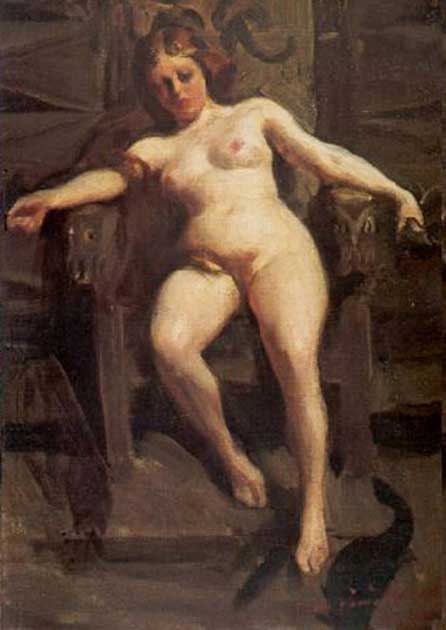
An intimate depiction of Freya, the Norse goddess of love, by Anders Zorn in 1901. Freya is shown in the nude, enthroned in her hall at Folkvangar, holding a chalice and accompanied by a black cat. (Public domain)
The Legacy of Freya, the Norse Goddess of Love
Whilst there does not seem to have been a cult of Freya, there are a large number of places in Sweden and Norway that many believe are related to her name. Examples include Frøihov (from Freyjuhof, “Freyja's temple”) and Frǫvi (from Freyjuvé, “Freyja's shrine”). Such examples demonstrate a clear recognition of Freya’s influence on life.
Whilst Freya is remembered today as the Norse goddess of love it is evident that she was far more complex. The fact that she features in so many of the surviving Norse myths demonstrates her prevalence within early Norse religion.
Top image: Painting of Freja by John Bauer. Source: Public domain
By Molly Dowdeswell
References
Christensen, C. No date. “Freyja: The Norse Goddess of Love, Witchcraft, and War” in Scandinavia Facts. Available at:https://scandinaviafacts.com/freyja-norse-goddess-love-witchcraft-war/
Groeneveld, E. 19 February 2018. “Freyja” in World History. Available at: https://www.worldhistory.org/Freyja/
McCoy, D. No date. “Freya” in Norse Mythology for Smart People. Available at: https://norse-mythology.org/gods-and-creatures/the-vanir-gods-and-goddesses/freya/
Skjalden. 13 August 2020. “Freya the Goddess of love and fertility in Norse mythology” in Nordic Culture. Available at: https://skjalden.com/freya/
The Editors of Encyclopaedia Britannica. 22 December 2021. “Freyja” in Britannica. Available at: https://www.britannica.com/topic/Freyja
Skjalden. 11 March 2018. “Völva the Viking Witch or Seeress” in Nordic Culture. Available at: https://skjalden.com/volva-the-viking-witch-or-seeress/


















